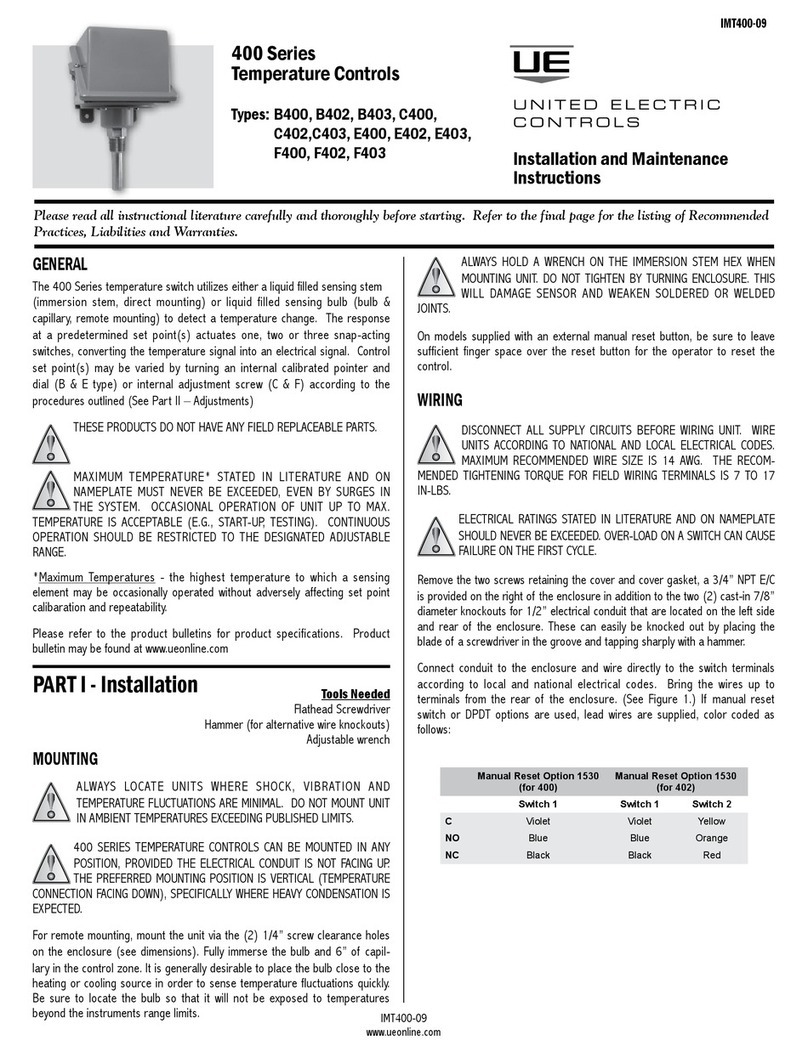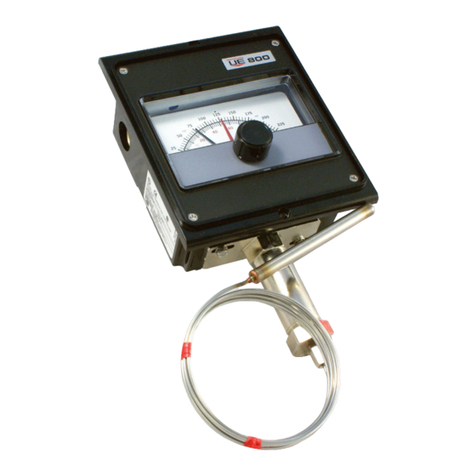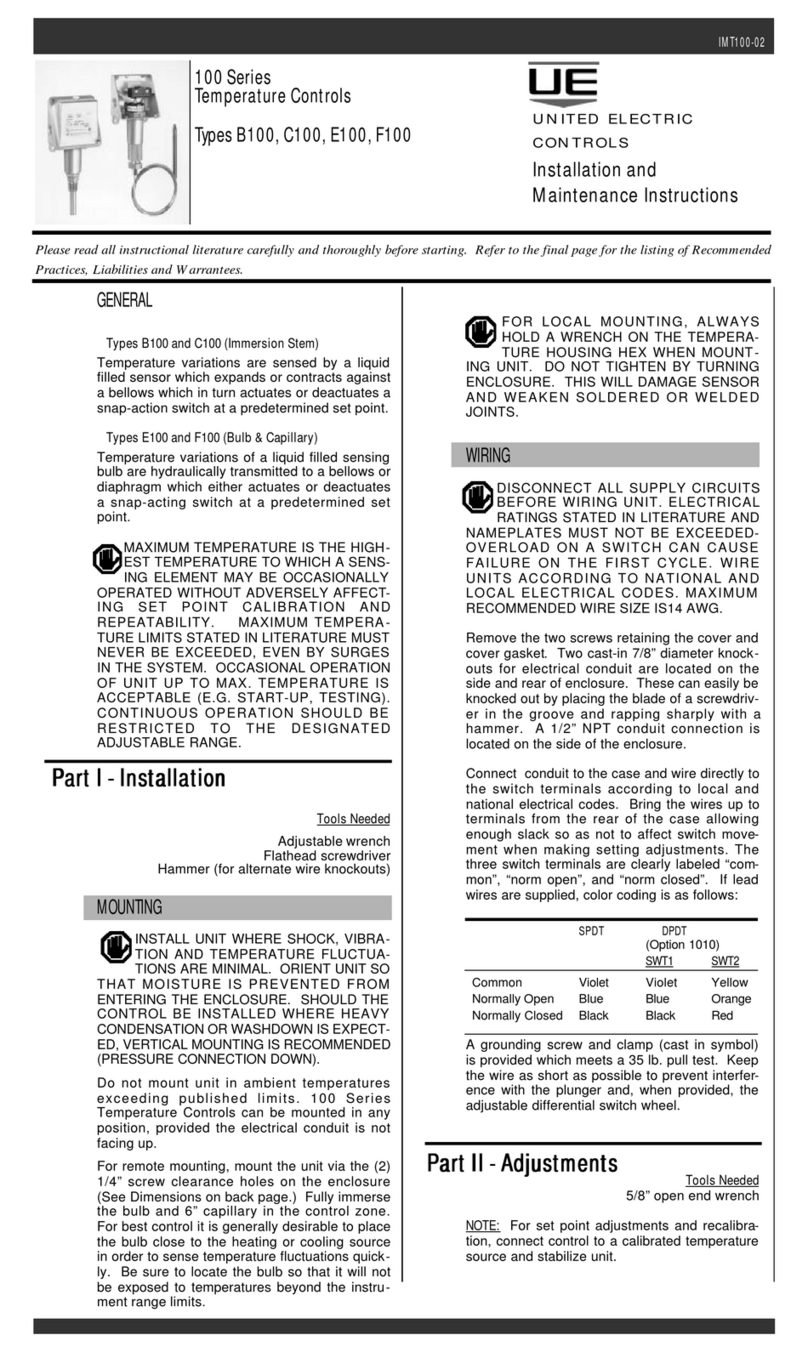
6 THE SENSOR BOX™
IM-TSB-00
RECOMMENDED PRACTICES AND WARNINGS
United Electric Controls Company recommends careful consideration of the following factors when specifying and installing UE pressure and tempera-
ture units. Before installing a unit, the Installation and Maintenance instructions provided with unit must be read and understood.
• To avoid damaging unit, maximum temperature limits stated in literature and on nameplates must never be exceeded, even by surges in the
system. Operation of the unit up to maximum temperature is acceptable on a limited basis (i.e., start-up, testing) but continuous operation must be
restricted to the designated adjustable range. Excessive cycling at maximum temperature limits could reduce sensor life.
• A back-up unit is necessary for applications where damage to a primary unit could endanger life, limb or property. A high or low limit switch is
necessary for applications where a dangerous runaway condition could result.
• Install unit where shock, vibration and ambient temperature fluctuations will not damage unit or affect operation. Orient unit so that moisture does
not enter the enclosure via the electrical connection. When appropriate, this entry point should be sealed to prevent moisture entry.
• Monitor operation to observe warning signs of possible damage to unit. Check unit immediately.
• Preventative maintenance and periodic testing is necessary for critical applications where damage could endanger property or personnel.
• Wire unit according to local and national electrical codes, using wire size recommended in installation sheet.
• Use only factory authorized replacement parts and procedures.
• Do not mount unit in ambient temperature exceeding published limits.
For Sensor Box™ supplies and replacement parts, please refer to the
“Re-order Form” in your kit, or consult Applied Sensor Technologies.
LIMITED WARRANTY OF REPAIR AND REPLACEMENT
Seller warrants that the product hereby purchased is, upon delivery, free from defects in material and workmanship and that any such product
which is found to be defective in such workmanship or material will be repaired or replaced by Seller (F.O.B. UE Watertown); provided, however,
that this warranty applies only to equipment found to be so defective within a period of 18 months from the date of manufacture by the Seller.
Seller shall not be obligated under this warranty for alleged defects which examination discloses are due to tampering, misuse, neglect, improper
storage, and in any case where products are disassembled by anyone other than authorized Seller’s representatives.
EXCEPT FOR THE LIMITED WARRANTY OF REPAIR AND REPLACEMENT STATED ABOVE, SELLER DISCLAIMS ALL WARRANTIES WHATSOEVER WITH
RESPECT TO THE PRODUCT, INCLUDING ALL IMPLIED WARRANTIES OF MERCHANTABILITY OR FITNESS FOR ANY PARTICULAR PURPOSE.
LIABILITY LIMITATION
SELLER’S LIABILITY TO BUYER FOR ANY LOSS OR CLAIM, INCLUDING LIABILITY INCURRED IN CONNECTION WITH (I) BREACH OF ANY WARRANTY
WHATSOEVER EXPRESSED OR IMPLIED, (II) A BREACH OF CONTRACT, (III) A NEGLIGENT ACT OR ACTS (OR NEGLIGENT FAILURE TO ACT) COMMITTED
BY SELLER, OR (IV) AN ACT FOR WHICH STRICT LIABILITY WILL BE IMPUTED TO SELLER, IS LIMITED TO THE LIMITED WARRANTY OF REPAIR AND
REPLACEMENT STATED HEREIN. IN NO EVENT SHALL THE SELLER BE LIABLE FOR ANY SPECIAL, INDIRECT, CONSEQUENTIAL OR OTHER DAMAGES OF
A LIKE GENERAL NATURE, INCLUDING, WITHOUT LIMITATION, LOSS OF PROFITS OR PRODUCTION, OR LOSS OR EXPENSES OF ANY NATURE INCURRED
BY THE BUYER OR ANY THIRD PARTY.
APPLIED SENSOR TECHNOLOGIES
A Division of UNITED ELECTRIC CONTROLS
180 Dexter Avenue
Watertown, MA 02472 USA
Tel: 617-923-6966
Fax: 617-926-8411
http://www.ueonline.com
MP5001002


























